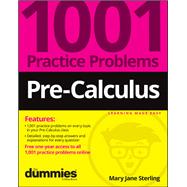Practice your way to a better grade in pre-calc
Pre-Calculus: 1001 Practice Problems For Dummies gives you 1,001 opportunities to practice solving problems from all the major topics in Pre-Calculus—in the book and online! Get extra help with tricky subjects, solidify what you’ve already learned, and get in-depth walk-throughs for every problem with this useful book. These practice problems and detailed answer explanations will turn you into a pre-calc problem-solving machine, no matter what your skill level. Thanks to Dummies, you have a resource to help you put key concepts into practice.
- Work through practice problems on all Pre-Calculus topics covered in school classes
- Read through detailed explanations of the answers to build your understanding
- Access practice questions online to study anywhere, any time
- Improve your grade and up your study game with practice, practice, practice
The material presented in Pre-Calculus: 1001 Practice Problems For Dummies is an excellent resource for students, as well as for parents and tutors looking to help supplement Pre-Calculus instruction.
Pre-Calculus: 1001 Practice Problems For Dummies (9781119883623) was previously published as 1,001 Pre-Calculus Practice Problems For Dummies (9781118853320). While this version features a new Dummies cover and design, the content is the same as the prior release and should not be considered a new or updated product.









